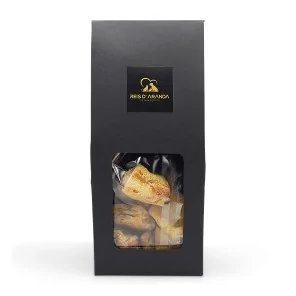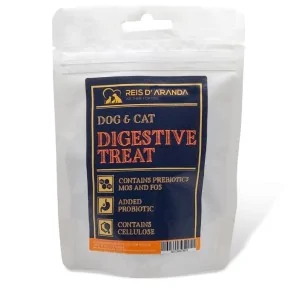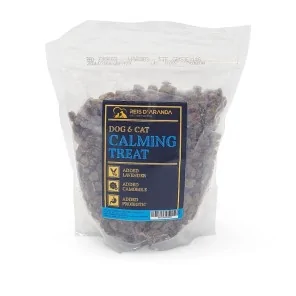Its name says it all: the Vienna blue rabbit comes from Austria. Not only is it beautiful with its shiny blue-grey...
THE MIORITZA ROMANIAN SHEPHERD DOG
INTRODUCTION
The roots of this shepherd dog lie in the Carpathian environment. This region of Romania is traditionally home to numerous flocks of sheep, but also to wolves. This is where the Romanian Mioritza shepherd comes into play. These large, calm shepherds have been protecting their flocks from wolves, lynxes and bears for centuries by their presence alone.
THE ORIGIN OF THE ROMANIAN MIORITZA SHEPHERD DOG
The Romanian Mioritza shepherd, which in Romanian means sheep, is a very old breed originating in the region of Sibiu at the foot of the Transylvanian Carpathian Mountains. Like the Bukovina Shepherd and the Carpathian Shepherd, it is a Molossian breed which may have originated from Asian dogs, as in the case of the Swiss Cattle Dogs, and which like them have remained in their relatively isolated areas of distribution with little variation since the arrival of the Romans in Dacia in the 2nd century A.D., thanks to their usefulness. It was not made known to the general public until 1935 at a dog show in Bucharest and after the Second World War and the introduction of communism, the breed experienced very low times until the restoration of the Romanian Kennel Club in 1969. The standard was drawn up by the Romanian Kennel Club in 1981, revised in 2002 and accepted by the FCI in 2005. Today, thanks to its vigorous appearance, there are many fans of this breed in Romania.
THE STANDARD OF THE MIORITZA ROMANIAN SHEEPDOG
GENERAL APPEARANCE: Large in size, but never heavy.
Vigorous and spectacular. The coat is long and well matted on the head, the whole body and the limbs. Males are taller and larger than bitches.
IMPORTANT PROPORTIONS:
- Length of body/height at withers, 11 : 10.
- The height of the chest should correspond to 50% of the height at the withers.
Withers. - The muzzle is slightly shorter than the skull.
HEAD: Powerful, massive. Large in relation to the body.
CRANIAL REGION:
SKULL: Of medium width, slightly bulging. The upper profiles of the skull and muzzle are more or less parallel. Seen from the front, the upper profile is slightly bulging. The zygomatic arches are not very marked. The occipital protuberance is well marked.
STOP: Not very marked.
FACIAL REGION:
TRUFA: Broad, well developed, black.
HOCIO: Slightly shorter than the skull; well developed, tapering progressively towards the nose, never pointed; the jaw is strong.
BELLIES: Thick, well hung, well pigmented.
JAWS / TEETH: Powerful jaws; complete dentition (absence of PM1 and M3 permitted), strong, healthy, with white, well set in teeth. The articulation is scissor-like.
EYEBROWS: Not protruding.
EYES: Medium sized, oblique. Hazel, dark brown or slightly lighter in colour, never yellow. The eyelids are well pigmented. The expression is calm and intelligent.
EARS: Relatively high set, V-shaped, slightly rounded at the tip. They are 10-15 cm long, pendant and close fitting to the cheeks. Detachment is forbidden.
NECK: Of medium length, broad and powerful. No dewlap present.
BODY: Well developed.
TOP LINE: Straight, well pronounced.
HEIGHT AT THE CROSS: Mediumheight.
BACK: Horizontal, strong and muscular.
LOIN: Moderately long, broad and well muscled.
Croup: Muscled and moderately sloping towards the root of the tail.
CHEST: Not too long. Broad and its height corresponds to approximately half the height at the withers. The ribs are well sprung.
BOTTOM LINE AND BELLY : Slightly sloping, without being sloping.
TAIL: Set on high. In repose, it hangs down to the hock or slightly above it. When the dog is attentive or in action, it is raised, slightly bent and may extend beyond the level of the back, but never curled over the back. Caudectomy is forbidden.
LIMBS
FORELEGS:
GENERAL APPEARANCE: Seen from the front or in profile, they are plumb.
Shoulders: Of medium length, oblique, very muscular and close to the body. Scapular-humeral angulation of approximately 100-105 degrees.
ARM: Of medium length, well muscled.
ELBOW: Close to the body, turning neither in nor out.
FOREARM: Sufficiently long, powerful and muscular.
BODY: Firm.
Pastern: Slightly sloping, seen from the side.
HANDS: Oval, compact and solid. Fingers close together and arched, nails ashen grey.
HIND LIMBS:
GENERAL APPEARANCE: Well muscled and powerful. Seen from behind, straight and parallel. Angulations not very open.
THIGH: Long, broad and well muscled.
KNEE: The femur-tibial angle is approximately 100-105 degrees.
LEGS: Sufficiently long, muscular, good bone structure.
Hock: Of medium height, strong, well laid back, turning neither in nor out.
METATARSUS: Not too long. Seen in profile, robust and almost vertical. The presence of dewclaws should not be penalized.
FEET: Slightly longer than above.
GAIT / MOVEMENT: Harmonious, loose, well coordinated, powerful and easy. The preferred movement is the trot. The canter is even and balanced.
SKIN: Thick, well stretched, well pigmented.
COAT
HAIR: The coat is abundant on the head and body, its texture is rough. It is straight and at least 10 cm in length. The undercoat is dense and soft, light in colour. On the limbs, the coat is shorter. The tail is very bushy.
COLOUR:
- PARTICOLOR: The background should be white with well defined black or grey patches.
- SOLID: Dogs of uniform white or grey colour.
SIZE AND WEIGHT:
HEIGHT AT WITHERS
- Males: minimum 70 cm, ideally 75 cm.
- Bitches: minimum 65 cm, ideally 70 cm.
WEIGHT: In proportion to size.
FAULTS: Any departure from the foregoing points should be considered a fault and the seriousness with which the fault should be regarded should be in exact proportion to its degree and its effect upon the health and welfare of the dog.
- Obese or weak dog.
- Tail bent or ring-shaped.
- Lack of teeth other than PM1.
- Heavy movement.
SERIOUS FAULTS:
- Insufficiently marked sexual characteristics.
- Atypical expression.
- Round, bulging eyes.
- Ocular heterochromia (eyes of different colour).
- Straight ears.
- Too short hair (less than 8 cm).
- Curly coat.
- Sunken, convex or deep upper margin.
- Feet open, turning inwards or outwards (knock-kneed).
- Very open angulations of the hindquarters.
- Cow hocks.
- Presence of mottled patches.
DISQUALIFYING FAULTS:
- Aggressiveness or extreme shyness.
- Any dog showing clear signs of physical or behavioural abnormalities.
- Atypical dog.
- Lack of incisors or canines.
- Overshot or undershot mouth.
- Albinism.
- Absence of tail or very short tail.
- Docked tail.
- Height at withers less than 68 cm in males.
- Height at withers less than 63 cm for bitches.
N.B.:
- Males should have two apparently normal appearing testicles fully descended into the scrotum.
- Only functionally and clinically healthy dogs, with breed typical conformation, should be used for breeding.
THE HEALTH OF THE MIORITZA ROMANIAN SHEPHERD DOG
The Mioritza Romanian Shepherd Dog is a rustic and fairly healthy breed with no major health or congenital problems, although it is not exempt from the typical afflictions of giant breeds such as hip dysplasia, elbow dysplasia and stomach torsion, among others. It is also advisable to check his ears regularly to prevent infections and fungus, as well as his eyes. In the case of a working dog, or one that does a lot of work in the field, it is advisable to periodically inspect its coat to detect any spikes, fleas or other parasites in the skin or hair. In particular, the legs and the inside of the ears should be checked. Beware of ticks as they can transmit babesiosis, ehrlichiosis or hepatozoonosis, among others.
THE PRSONALITY OF THE MIORITZA ROMANIAN SHEPHERD DOG
In general, the Mioritza Romanian Shepherd Dog exudes calmness. However, if danger threatens, he reacts with lightning speed and bravely defends his flock. Like many sheepdogs, he also shows great loyalty to his pack, with whom he loves to spend time. In addition, he gets along well with children, but should always have the possibility of shelter. He is a great playmate, but not a toy. Although he is very attached to his people of reference, he is aloof with strangers. On seeing them enter his territory, he barks in a deep voice. His behaviour with other dogs can also be problematic, but this can be corrected with good socialisation in puppyhood.
It requires experience with dogs and a good deal of knowledge and perseverance to own a Mioritza Romanian Shepherd.
CONCLUSION
Renowned for its strong and determined character, the Mioritza Romanian Shepherd also shows affection and loyalty to its family. However, he may exhibit territorial behaviour and distrust towards strangers, manifesting a protective instinct that defines his role as a guardian.
Leave a comment
Log in to post comments
















